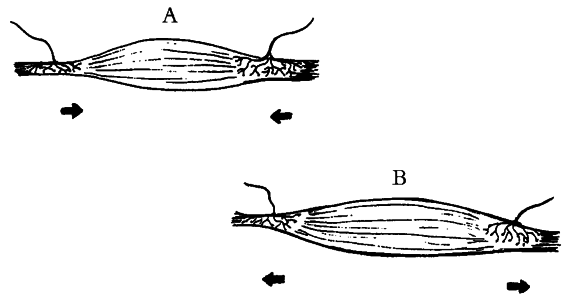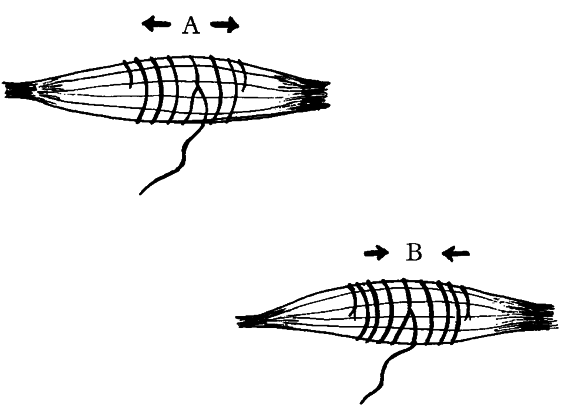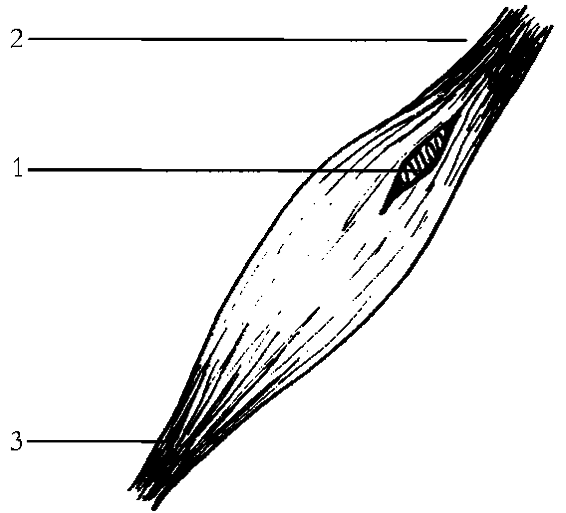Equine Massage: A Practical Guide (22 page)
Read Equine Massage: A Practical Guide Online
Authors: Jean-Pierre Hourdebaigt

Massage Techniques
105
5.6 Schematic Diagram of a
Trigger Point,Trigger Point
Technique:
Toxin buildup in
Toxin buildup
the belly of the muscle, resulting
in a trigger point.
specific area will contribute greatly to the effectiveness of your trigger point technique. It will loosen the tissue fibers and boost circulation over the area. Use hot packs, hot towels, or electric pads (see chapter 4).
After thoroughly warming up and loosening the area with massage moves (strokings, wringings, kneadings, all interspersed with effleurages every 20 seconds), you should apply a light pressure at the location of maximum tenderness, or directly over the nodule that your fingers have detected, and hold until the muscle relaxes.
The release process might take just a few seconds for recently formed trigger points, or up to 2 or 3 minutes for more chronic trigger points. Intersperse your work with effleurages every 30
seconds.
Your initial touch will likely be very painful to the horse. But after 20 to 30 seconds, the tenderness will decrease tremendously.
When dealing with a silent trigger point you might consider raising your pressure up to 15 or 20 pounds, depending on the muscular mass you are working on and the horse’s reaction. For an acute trigger point, you should hold a light pressure (2 to 5 pounds) for most of the application, only raising the pressure slightly to 10 or 15
pounds maximum at the end when you feel the trigger point releasing. When it may appear dangerous to apply strong pressure because of the underlying structure (the brachiocephalic muscle of the neck, for example), you may squeeze or pinch that trigger point between your thumb and index finger. Use the same pressure and duration as you would in any other situation.
Do not use more pressure than necessary; trigger points can be over treated. The ideal pressure is the one that gives a sensation somewhere between pleasure and pain. Evaluate the pressure applied relative to your horse’s feedback; watch his eyes.You may apply a continuous or varying pressure. If the pressure is too heavy, the horse will certainly let you know. Play it safe. Some old, chronic trigger points may need up to 3 minutes before completely releasing.
106
Equine Massage
Once released, trigger point areas should be drained thoroughly with plenty of effleurages.Then, to further the treatment, use light frictions along the length of the whole muscle fiber—or the whole muscle bundle—in which the trigger point was located.
This, with the effleurage, will increase the effectiveness of the drainage.
Drainage after trigger point release is very important. As you break down a long-standing buildup of toxins, you must move those toxins into the bloodstream in order to avoid creating a worse condition. Drainage will also bring fresh blood, new oxygen, and nutrients to greatly assist the healing process.
The area where the trigger point (or points) was located might be very sore for a few hours or even a day or so. In that case wait a day or two before working it again. In the meantime, apply effleurages, wringings, and gentle finger frictions or large kneadings daily if possible to increase circulation and assist recovery. If some degree of inflammation is present, use cold hydrotherapy after the treatment to soothe the nerve endings and stimulate circulation.
The trigger point technique is used very often as part of the maintenance routine (chapter 6) and in sports massage treatments.
You can consider using the trigger point technique as a preventive measure, particularly if the symptoms have just developed during exercise. Just ensure sufficient drainage before, and especially after, treatment.
Lightly exercising your horse (longeing, walk/trot) immediately after this type of work is recommended; it will allow the muscles to recover their full power and function as they were meant to.
The Neuromuscular
Technique
The neuromuscular technique is used to treat hypotonic or hypertonic muscles. As the word “neuromuscular” suggests, the neuromuscular technique works on the sensory nerve cells located in a muscle.There are two types of muscular sensory nerve cells: the Golgi tendon sensory nerve cells and the muscle spindle sensory nerve cells. Both act as reporting stations, providing the central nervous system with information regarding the position of the muscle at any given moment (
proprioception
) and how much of a workload is being developed by this muscle.
Start your technique with light stroking for several seconds to relax and comfort your animal. Weave your moves into effleurages, wringings, and kneadings to stimulate circulation and warm up the area.

Massage Techniques
107
The Golgi
The Golgi tendon receptors are located in both tendons, origin and insertion, of a muscle.The
origin tendon
is the muscle part that anchors to the most stable, least movable bone, whereas the
insertion tendon
attaches the muscle to the movable part, so that during contraction the insertion is brought closer to the origin.The origin tendon is usually stronger and bigger than the insertion tendon because its anchor attachment sustains greater stress, which is responsible for most of the problems found close to the origin tendons. The Golgi tendon sensory receptors indicate how hard the muscle is working. If the sensory nerves detect an overload, they will stop the muscle’s activity to prevent damage.
The Golgi tendon sensory nerve cell can be activated manually by massage manipulations, which will either tone or relax the muscle. You have to know the muscle structure well in order to use this technique effectively. After thoroughly warming up the muscle with massage moves, use your thumbs to apply vigorous kneadings (10 to 15 pounds of pressure) on the tendons. For big or deep-seated muscles, you might consider using the elbow technique (up to 20 pounds of pressure). If a strong inflammation is present in the muscle fibers, use cold hydrotherapy (chapter 4) before applying the technique, and then use lighter pressure (5 to 8 pounds) in your kneadings.When finished, drain thoroughly and reapply cold hydrotherapy.
To tone up a weak muscle, apply pressure on the tendon, firmly stretching the tendons toward the center of the muscle. This action will stretch the sensory nerve cell and send impulses to the central nervous system. The central nervous system will respond by improving the muscle tone. It is better to work both tendons simultaneously, but working them alternately will also do.
5.7 Neuromuscular Technique:
Golgi Nerve Apparatus
(A) to tone
(B) to relax

108
Equine Massage
To relax a hypertonic (overused) muscle, use the same technique; only reverse the direction of your pressure. Pressure is firmly applied on the tendons, toward the bone and away from the muscle belly.This move will produce a reflex action that will relax the muscle.
The Muscle Spindle
Very sensitive and complex, the muscle spindle sensory nerve cell coils around the muscle fiber. It sends feedback information to the central nervous system, reporting on the relative length of the fibers and any changes to it. It adjusts the length of the muscle in which it lies, setting the tone by increasing or decreasing it. If the muscle is abruptly elongated, the muscle spindle nerve cell will discharge signals immediately to the brain and contribute to an instant muscle fiber contraction, thus preventing a muscle tear.
This nervous reflex reaction happens very quickly.
The muscle spindle sensory nerve cell can be activated manually by massage. First use your thumbs or fingertips to apply gentle frictions (5 pounds of pressure) along the course of the muscle fibers to loosen the whole muscle bundle, reset the sensory nerve fibers, and contribute to the muscle’s readjustment.
Then, to tone the muscle, apply with your thumb or fingertips a firm pressure (10 to 15 pounds) over the center of the muscle belly and stretch the fibers toward the muscle ends. This action will stretch the nerve cell and produce a “tonifying” reflex in the muscle.Also, firmly frictioning the whole muscle bundle will produce a similar effect, activating and resetting the muscle spindle
5.8 Neuromuscular Technique:
Muscle Spindle Nerve
Apparatus
(A) to tone
(B) to relax
Massage Techniques
109
nerve cells. If the muscle appears inflamed, reduce your pressure to a gentle friction (5 to 8 pounds).
To relax the muscle, you need only reverse the technique.With your thumb or fingertips, apply firm pressure (10 to 15 pounds) over the muscle belly, pressing toward the center and shortening the muscle spindle sensory nerve cells. A reflex action will occur, releasing muscle tension.This technique is very effective in relieving hypertonic fibers, spasms, or cramps.
The muscle spindle and the Golgi tendon sensory nerve cells harmoniously work together to provide constant information to the central nervous system. Fatigue, stress, work overload, and boredom will acutely and possibly chronically affect those structures. Whenever you are massaging a muscle, work both types of sensory nerve cells. This will produce a strong reflex action from the central nervous system. Use a firm pressure (between 8 to 15
pounds, proportional to inflammation if any) because nerve cells are easily irritated.Work each muscle for 2 or 3 minutes at a time, interspersing effleurages every 20 or 30 seconds, but do not overdo the treatment. Evaluate the degree of inflammation. It is always better to work several short sessions than to overwork and further damage the tissues in one long session. Remember to use hydrotherapy to assist the efficiency of your treatment.
Stress Points
Many horses experience muscle tightness, resulting in reduced muscle action. Stress points are microspasms involving only a few fibers out of a whole bundle. However, these microspasm stress points can turn into full-blown muscle spasms. If a stress point is not inflamed, it is called a
“dormant” stress point.
If a stress point is inflamed, it called an
“active” stress point,
which will display more tenderness and will eventually produce heat and swelling.
How Stress Points Form
Stress points form as a result of great mechanical stress, causing micro-tearing of the muscle fibers. Heavy training, repetitive actions, weight overload, and strenuous effort are all examples of great mechanical stress.
Stress points also develop as a response to a trauma, such as a kick, a bump, or a fall, or as a result of overstretching. If a horse has been injured, during the recovery stage the muscular compensation will trigger formation of other stress points within the compensatory muscles. For example, a horse with a sore knee will develop compensatory stress points in the shoulder muscles, as well as in the muscle attaching the scapula to the rest of the body.

110
Equine Massage